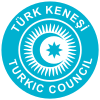Giray dynasty
This article needs additional citations for verification. (April 2012) |
| House of Giray | |
|---|---|
 | |
| Parent house | Borjigin Dynasty |
| Country | Crimean Khanate |
| Founded | 15th century - Hacı I Giray |
| Titles |
|
| Dissolution | Qasim: 1512 - Astrakhan: Kazan: 1783 - |
The House of Giray (Crimean Tatar: Geraylar, كرايلر, Ottoman Turkish: آل جنكيز, romanized: Âl-i Cengiz, lit. 'Genghisids'), also Girays,[1] were the Genghisid/Turkic dynasty that reigned in the Khanate of Crimea from its formation in 1427 until its downfall in 1783. The dynasty also supplied several khans of Kazan and Astrakhan between 1521 and 1550. Apart from the royal Girays, there was also a lateral branch, the Choban Girays (Çoban Geraylar). Before reaching the age of majority, young Girays were brought up in one of the Circassian tribes, where they were instructed in the arts of war. The Giray khans were elected by other Crimean Tatar dynasts, called myrzas (mırzalar). They also elected an heir apparent, called the qalgha sultan (qalğa sultan). In later centuries, the Ottoman Sultan obtained the right of installing and deposing the khans at his will.
Their early ancestor was Togay Timur (Tuqa Timur), a younger son of Jochi. The story of Girays begin with Öreng Timur, son of Togay Timur, receiving Crimea from Mengu-Timur.[2]
During Ottoman suzerainty[]
According to some scholars, the Girays were regarded[by whom?] as the second family of the Ottoman Empire after the House of Ottoman: "If Rome and Byzantium represented two of the three international traditions of imperial legitimacy, the blood of Genghis Khan was the third... If ever the Ottomans became extinct, it was understood that the Genghisid Girays would succeed them" [3]
During the 15th and early 16th centuries, the Giray Khan was second to the Ottoman Emperor - and thus superior to the Grand Vizier - in the Ottoman protocol. After the disobedience and 1584 removal of Mehmed II Giray, the Sultan demoted the Crimean Khan to the level of Grand Vizier. The Giray Khans were also sovereigns of their own realm. They could mint coins, make law by decree, and had their own tughras.
Alliances[]

The Crimean Khanate made alliances with the Polish–Lithuanian Commonwealth and with the Zaporizhian Sich. The assistance of İslâm III Giray during the Khmelnytsky Uprising in 1648 contributed greatly to the initial momentum of military successes for the Cossacks. The relationship with the Polish–Lithuanian Commonwealth was also strong - the dynasty of Girays would seek sanctuary in Lithuania in the 15th century before establishing themselves on the Crimean peninsula.
Downfall[]
After the khanate's annexation by Imperial Russia in 1783, the last khan Şahin Giray remained nominally in power until 1787, when he took refuge in the Ottoman Empire, and was executed in Rhodes.
Other dynasts were permitted by the Russian authorities to reside in their Bakhchisaray palace. Selim III's young son, Qattı Giray, was converted by missionaries to Protestantism and married a Scottish heiress, Anne Neilson.[4]
After downfall[]
After the execution of Şahin Giray, his family lived in Burgazada, Istanbul, after he was executed by Abdul Hamid I.[5]
The today's head of the House of Girays is living in London.[6][7]
See also[]
- History of the Turks
- List of Turkic dynasties and countries
- List of Crimean khans
- List of Kazan khans
Notes[]
- ^ Alternative spellings include Geray, Girey, Guirey, Ghirai, Ghiray, and Ghiray.
- ^ "HACI GİRAY I". TDV Encyclopedia of Islam (in Turkish). Istanbul: Turkiye Diyanet Foundation, Centre for Islamic Studies. 1988–2016.
- ^ Simon Sebag Montefiore, Prince of Princes: The Life of Potemkin. London, 2000.
- ^ Hakan Kırımlı, “Crimean Tatars, Nogays, and Scottish Missionaries: The Story of Kattı Geray and Other Baptised Descendants of the Crimean Khans”, Cahiers du monde russe 45, no. 1 (2004): 61–107.
- ^ FERİDUN EMECEN, "ŞÂHİN GİRAY", TDV İslâm Ansiklopedisi, https://islamansiklopedisi.org.tr/sahin-giray (14.07.2020).
- ^ "Татарский принц, потомок крымских ханов Гиреев-Чингизидов о национальном самосознании и преемственности благородных сынов Золотой Орды".
- ^ "Их Высочество Наследный принц Крыма и Золотой Орды Джеззар Раджи Памир Гирай (Cezzar Pamir Geray)".
- Crimean Khanate
- Crimean Khans
- European royal families
- Islam in Ukraine
- Turkic dynasties
